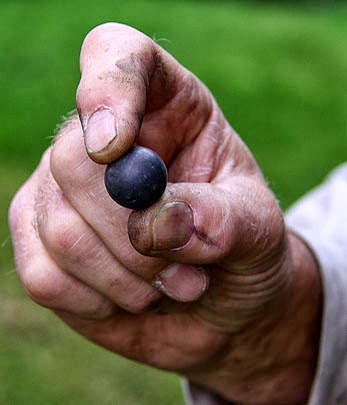sorry guys im gonna get physicsy on you
this is a .75 cal musket ball, fairly common in flintlock designs like the british brown bess

this is a .223 cal bullet (in its cartridge) better known as 5.56x45mm- M4s, M16s, and M429 SAWs are a few weapons that fire this

please note the differences in size. we're not counting the added length or width of the bullet's cartridge, because the ball doesn't come with a cartridge packed with powder like the bullet does.
now, it's very important to note that the ball is propelled by black powder, and the bullet is propelled by smokeless powder. modern smokeless powder is pretty potent compared to the black powder of the plate armor era.
with that aside, it's also very important to note how pressure works. if we were to make that 5.56mm bullet 10-15 grains heavier, the muzzle velocity would indeed be lower. however, due to the fact that the pressure is directly kept up by the bullet's presence in the barrel, the increase in recoil is what you'll notice a lot more.
so, in short, a good way to measure the stopping power of these rounds is by how much stopping power it hits your shoulder with when you fire it.
and i'm pretty sure there's a lot more recoil in a musket than a small-arms carbine.
that being said, we now have to tackle the shape of these projectiles.
the ball is aerodynamically inefficient in comparison to a bullet fired from a rifled barrel, and as a result will be slowed down by drag faster. this is part of why muskets are bad at long range. however, you can get relatively close in musket-vs-melee combat, in comparison to rifle-vs-rifle combat, which is what we see today.
also, the shape means that the energy applied to whatever gets hit by these projectiles yet again gives the bullet an advantage. think of the tip of a table knife, and the tip of a steak knife. you can poke stuff very easily with the steak knife, but the table knife? nah.
same principle applies in ballistic entry.
i'd say the 5.56mm round will penetrate more than the musket ball.
now let's consider armor quality.
iirc, at 600 meters, you'll get about 3mm entry from NATO-quality ball ammo through rolled homogenous armor - which is basically steel plating.
at closer ranges, like 50m, i'd say you could get about 5-6mm of entry from this same bullet.
now, medieval plate armor had about 1.5-3.25 inches of thickness, so any modern rifle could probably murder a knight in shining armor pretty easily.
HOWEVER, we've forgotten to take one incredibly important fact into account: modern steel and medieval steel are not the same quality at all. they are remarkably similar, though, so i'd say that 5.56mm ammo would only go another mm or two in.
so, if this .75 caliber ball with far superior weight compared to the 5.56mm bullet has even HALF the entry of the 5.56mm bullet, it could theoretically penetrate any part of your plate armor.
now let's add in a few fun and unpredictable variables: armor angling, distance, and the reliability of the human hand in pouring precise amounts of powder into a musket.
suddenly... the musket has trouble reliably penetrating. however, it's still a very real danger.
IN CONCLUSION, THE MUSKET WAS INDEED DANGEROUS BUT WAS NOT COMPLETELY RELIABLE FOR PENETRATING ARMOR.